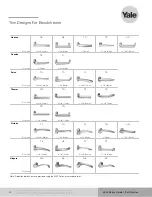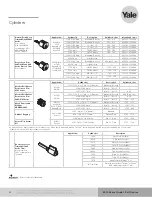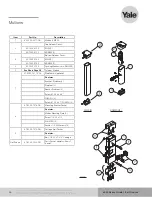
6000 Series Grade 1 Exit Devices
60
Concealed Vertical Rod Exit Devices
Copyright © 2015-2020, ASSA ABLOY Access and Egress Hardware Group, Inc. All rights reserved.
Reproduction in whole or in part without the express written permission of ASSA ABLOY Access and
Egress Hardware Group, Inc. is prohibited. Patent pending and/or patent www.assaabloydss.com/patents.
6120
Rods should move freely inside door. Bolts extend automatically
when door closes and top strike is tripped. Top bolt should retract
flat . Bottom bolt should travel 1/2" and engage 3/8" into strike in
down position, without dragging on floor surface in up position.
If top latch does not engage properly check alignment. When
locked, latch bolt should not be preloaded by strike (
Area A
).
Shim or reposition strike if necessary.
Rod Adjustment for Bolt Throw
1. Remove Latch assembly cover screws and cover.
2. Use 3/32" Allen wrench to loosen set screws
C
1
and
C
2
.
3. Adjusting screws
B
1
and
B
2
only provide fine rod adjustment. If
screws bottom out before proper device operation, door and
device must be removed. Larger adjustments may then be made
either by threading rod in or out, or by moving cotter pin to differ-
ent hole in rod.
4.
Adjust top rod first.
With device in dogged position (panic
devices) or touchbar fully depressed (fire devices), adjust top
rod so that the top latchbolt is flush and the hold back feature is
engaged . Lengthen top rod an additional 1/2 turn.
5.
Adjust bottom rod.
With top latch retracted in hold back posi-
tion, and touch bar dogged or fully depressed, adjust bottom
rod so that the deadbolt clears the strike by 1/16". The bottom
rod should be in position in the active case with the square head
of the connector hanging in the slide.
6.
Check device operation
by opening and closing the door.
When present, operate the device with the outside trim. An ad-
ditional minor adjustment may be required for full retraction and
correct strike engagement.
7. When finished, lock adjusting screws in place with Allen set
screws.
Caution:
To avoid thread damage and provide positive locking,
be sure Allen set screws engage flats on adjusting screws.
Maintenance
1. Periodically remove covers and coat exposed mechanisms
with an appropriate lubricant. This is regularly required in cor-
rosive environments for proper product operation.
2. Check mounting fasteners periodically. Retighten if found
loose. Apply screw locking compound or change part fasten-
ers if screws continue to back out.
3. Periodic checks and adjustments of rods may be required to
compensate for door or frame sag.





































